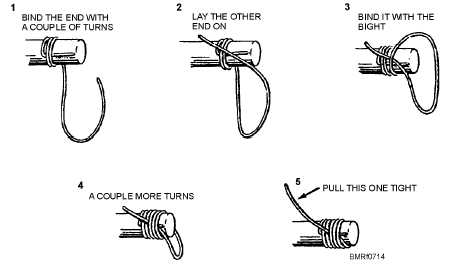CAUTION
Snapback is extremely dangerous and has
caused severe injuries and death. The utmost
caution must be observed when working with
or around all synthetic lines.
WIRE ROPE
The basic unit of wire rope construction is the
individual wire, which is made of steel or other metal
and comes in various sizes. These wires are laid together
to form strands. The number of wires in a strand varies
according to the purpose of the rope. A number of
strands are laid together to form the wire rope itself.
Wire rope is designated by the number of strands
per rope and the number of wires per strand. For
example, a 6 by 19 rope will have 6 strands with 19
wires per strand. It may have the same outside diameter
as a 6 by 37 wire rope, which will have 6 strands with 37
wires of much smaller size per strand. The more wires
per strand, the more flexible the rope. Rope with fewer
and larger wires per strand is more resistant to external
abrasion.
The strands of the wire rope are laid up around a
central core, which may be only a single wire, a single
strand of wire, or hemp. A hemp core contributes
flexibility, cushions the strands as the wire rope
contracts under strain, and holds a portion of lubricant
for continuous lubrication. A wire core is stronger than
hemp and can be used where conditions, such as high
temperatures, would damage a hemp core.
WHIPPINGS
Whippings are bindings on the ends of rope that
keep the rope from unlaying. On line, whippings are
made with cord, such as sail twine or with marline. The
ends of all line must be whipped because of the frequent
need for passing the ends through rings and pad eyes
and for reeving them through blocks. Unlaid and frayed
ends of line are unsightly and unseamanlike and waste
many feet of line. Knots or backsplices in the end of a
line are not allowed, nor are friction tape or wire
whippings. Knots and backsplices will jam in a block;
friction tape will not hold for long; and wire may tear a
line-handler’s hands.
The most secure whipping is made with the aid of a
sail needle and palm. However, an excellent whipping
can be made without a needle if the procedure shown in
figure 7-14 is followed. First, lay one end of the
whipping along the line, bind it down with a couple of
turns, and snug up the edges. Then lay the other end on
in an opposite direction with the body portion of the
whipping, continuing with several more turns from the
bight of the whipping. The whipping length should be
about equal to the diameter of the line being whipped.
Snug up the edges and cut off the twine close to the line.
This type of whipping is a temporary one. If the line is to
7-14
Student Notes:
Figure 7-14.—Plain whipping a line.

